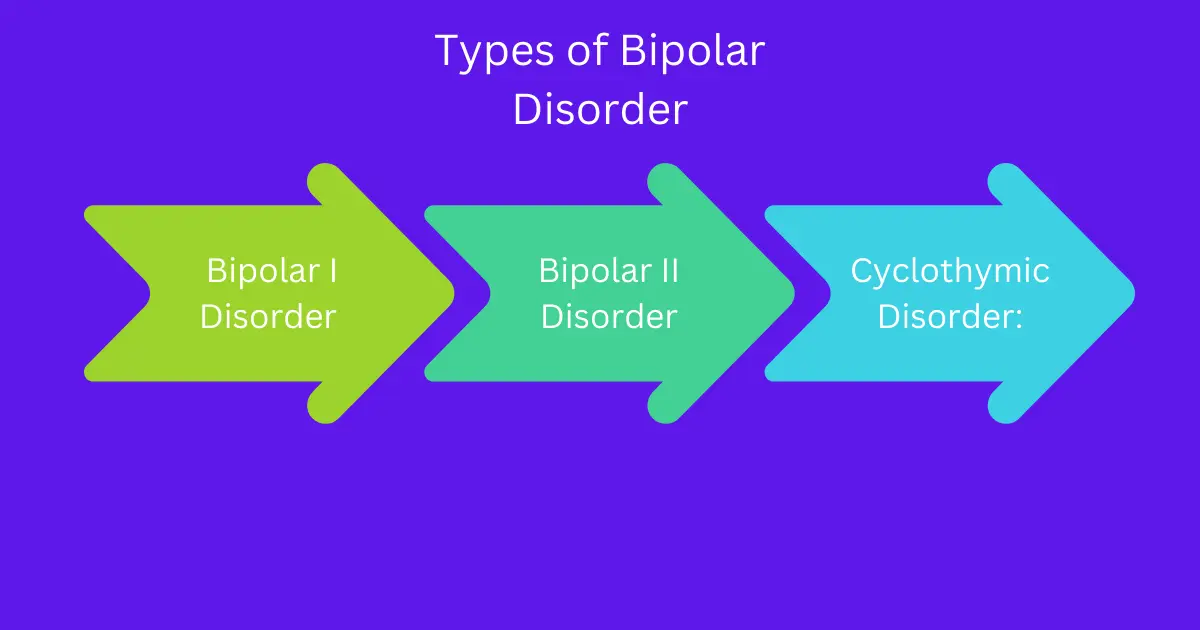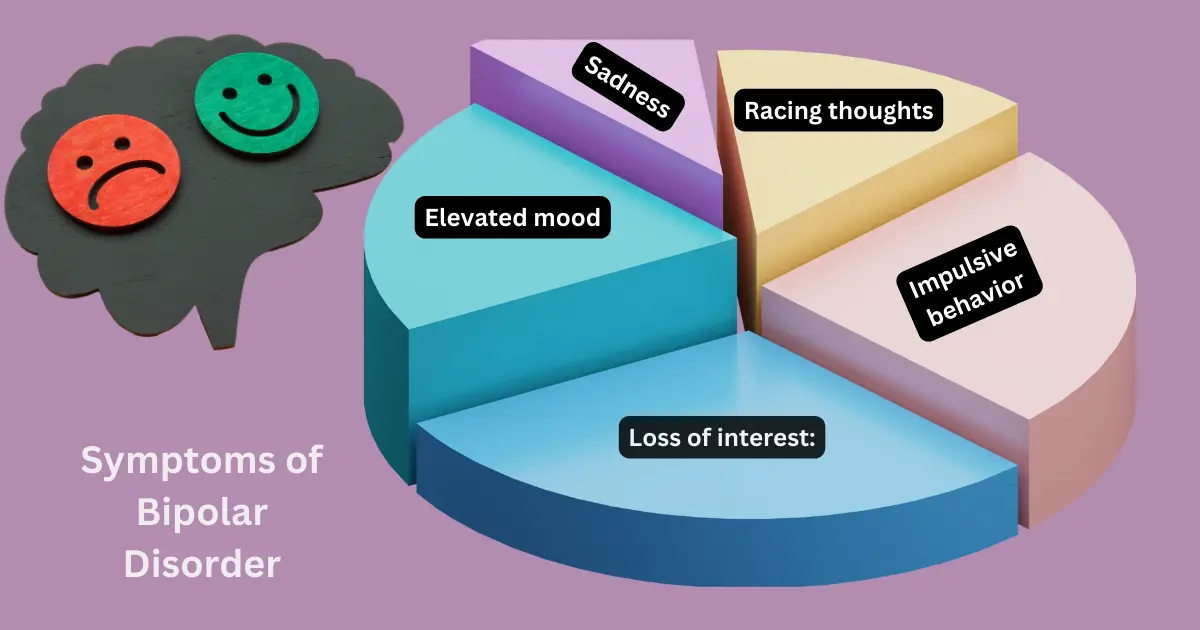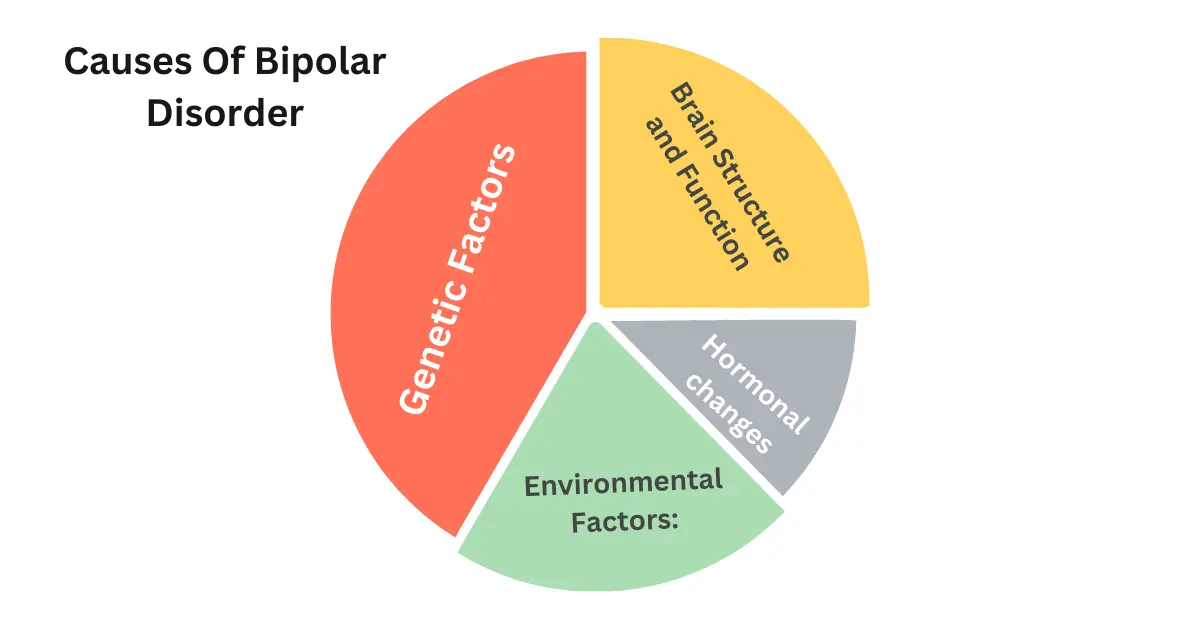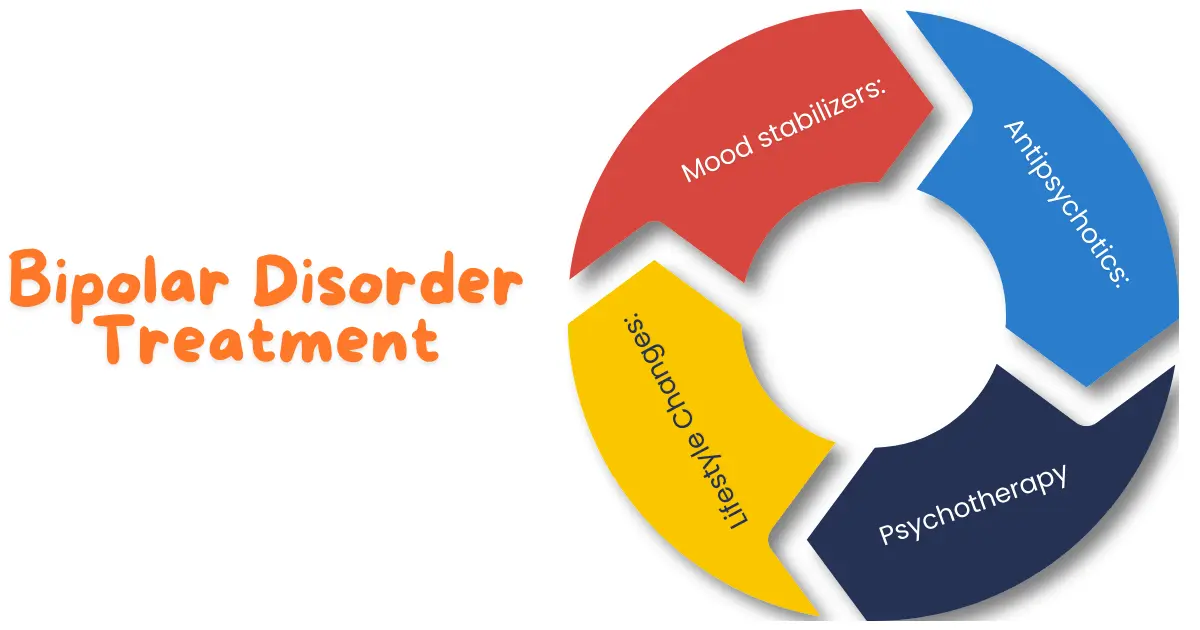Are you or someone you know struggling with extreme mood swings? You might be dealing with bipolar disorder.
This guide will help you understand this complex mental health condition. We’ll break it down in simple terms. You’ll learn about symptoms, treatments, and how to live well with bipolar disorder.

Table of Contents
Toggle1. What Is Bipolar Disorder:Understanding The Basics
Bipolar disorder is more than just mood swings. It’s a serious mental health condition. It affects how you feel, think, and act.
People with bipolar disorder experience intense emotional states. These states occur in distinct periods called “mood episodes.”
What are these mood episodes?
- Manic episodes: Feeling extremely “up,” elated, irritable, or energetic
- Depressive episodes: Feeling very “down,” sad, indifferent, or hopeless
- Mixed episodes: Experiencing both manic and depressive symptoms
How common is bipolar disorder in the United States?
- About 2.8% of U.S. adults have bipolar-disorder. That’s over 7 million people.
- The average age of onset is 25 years old.
- It affects men and women equally.
Did you know?
- Bipolar disorder is the 6th leading cause of disability in the world.
- Many famous Americans have been diagnosed with bipolar-disorder. This includes actress Carrie Fisher, musician Demi Lovato, and entrepreneur Ted Turner.
2. Types of Bipolar Disorder: It’s Not One-Size-Fits-All

Bipolar disorder isn’t just one condition. There are several types. Each type has its own pattern of symptoms.
Bipolar I Disorder
- This is the classic form of bipolar-disorder.
- You must have at least one manic episode to be diagnosed with Bipolar I.
- Manic episodes typically last at least 7 days.
- Depressive episodes may also occur. These usually last at least 2 weeks.
- About 0.6% of American adults have Bipolar I disorder.
Bipolar II Disorder
- This type involves a pattern of depressive and hypomanic episodes.
- Hypomanic episodes are less severe than full-blown mania.
- Depressive episodes are more frequent in Bipolar II.
- About 0.8% of American adults have Bipolar II disorder.
Cyclothymic Disorder
- This involves numerous periods of hypomanic and depressive symptoms.
- Symptoms last for at least 2 years in adults (1 year in children and teens).
- Symptoms don’t meet the full criteria for hypomanic or depressive episodes.
- About 0.3% of American adults have Cyclothymic Disorder.
Other Specified and Unspecified Bipolar and Related Disorders
- These categories include bipolar symptoms that don’t fit the other three types.
- For example, someone might have hypomanic episodes without depressive episodes.
- Or they might have very short episodes that don’t meet the duration criteria.
3. Recognizing the Signs: Symptoms of Bipolar Disorder

Bipolar disorder symptoms vary widely. They depend on which mood episode a person is experiencing. Let’s break down the symptoms for each type of episode.
Manic Episode Symptoms
During a manic episode, you might:
- Feel extremely happy or “high”
- Have lots of energy
- Feel like you don’t need much sleep
- Talk very fast about many different things
- Feel like your thoughts are racing
- Think you can do many things at once
- Do risky things, like spend too much money or have unsafe sex
- Feel very important, talented, or powerful
Depressive Episode Symptoms
During a depressive episode, you might:
- Feel very sad, “down,” or hopeless
- Have very little energy
- Have trouble sleeping too much or too little
- Feel like you can’t enjoy anything
- Feel worried and empty
- Have trouble concentrating
- Forget things a lot
- Eat too much or too little
- Feel tired or “slowed down”
- Think about death or suicide
Hypomanic Episode Symptoms
Hypomanic episodes are like manic episodes, but less severe. You might:
- Feel very good or “up”
- Have more energy than usual
- Feel more active and productive
- Need less sleep
- Feel more outgoing or talkative
Mixed Episode Symptoms
In a mixed episode, you have symptoms of both mania and depression at the same time. You might:
- Feel very “up” and energetic but also very sad
- Have trouble sleeping but also feel tired
- Have racing thoughts about sad or negative things
- Feel very agitated or irritable
Did you know?
- About 82.9% of people with bipolar-disorder have serious impairment. This makes it one of the most serious mental health conditions.
- Bipolar disorder is often misdiagnosed. On average, it takes 5 to 10 years for people to get the right diagnosis.
4. Causes Of Bipolar Disorder? Unraveling the Mystery

The exact cause of bipolar disorder isn’t known. But research suggests it’s a mix of factors. Let’s explore what might contribute to bipolar disorder.
Genetic Factors
- Bipolar disorder tends to run in families.
- If you have a parent or sibling with bipolar-disorder, you have a higher chance of developing it.
- But having a family history doesn’t mean you’ll definitely get bipolar disorder.
- Scientists have found several genes that may increase the risk.
Brain Structure and Function
- Brain scans show subtle differences in people with bipolar disorder.
- These differences are in areas that control emotions and behavior.
- But these brain changes aren’t seen in everyone with bipolar disorder.
Environmental Factors
Certain life events or circumstances might trigger bipolar-disorder in people who are at risk. These include:
- High stress
- Traumatic experiences
- Drug or alcohol abuse
- Major life changes (like starting college or losing a job)
- Seasonal changes
- Lack of sleep
Chemical Imbalances
- Bipolar disorder may be linked to problems with certain brain chemicals.
- These chemicals, called neurotransmitters, include serotonin, dopamine, and norepinephrine.
- They play a role in mood regulation.
Did you know?
- About 85% of people with bipolar-disorder have a family member with depression or bipolar disorder.
- Bipolar disorder is equally common in all races, ethnic groups, and social classes in the United States.
5. Diagnosis Of Bipolar Disorder: The Road to Understanding
Getting a proper diagnosis is crucial. It’s the first step towards effective treatment.
But diagnosing bipolar-disorder can be tricky. Here’s what you need to know about the diagnostic process.
Steps in Diagnosis
- Medical History: Your doctor will ask about your symptoms, family history, and any medications you’re taking.
- Physical Exam: This helps rule out other conditions that might be causing your symptoms.
- Psychological Evaluation: A mental health professional will assess your thoughts, feelings, and behavior patterns.
- Mood Charting: You might be asked to keep a daily record of your moods, sleep patterns, and other symptoms.
- Diagnostic Criteria: Your doctor will compare your symptoms to the criteria in the Diagnostic and Statistical Manual of Mental Disorders (DSM-5).
Challenges in Diagnosis
- Bipolar disorder symptoms can overlap with other conditions.
- Many people with bipolar-disorder also have other mental health conditions.
- Some people only seek help during depressive episodes.
- Manic episodes might be mistaken for normal periods of high energy.
Conditions That May Be Confused with Bipolar Disorder
- Major Depressive Disorder
- Attention-Deficit/Hyperactivity Disorder (ADHD)
- Borderline Personality Disorder
- Schizophrenia
- Substance Use Disorders
Importance of Accurate Diagnosis
- A correct diagnosis leads to proper treatment.
- Misdiagnosis can lead to ineffective treatment or even make symptoms worse.
- If you think you might have bipolar-disorder, it’s important to see a mental health professional.
Did you know?
- On average, people with bipolar disorder see three to four doctors and spend over 8 years seeking treatment before receiving a correct diagnosis.
- About 69% of people with bipolar disorder are initially misdiagnosed.
6. Bipolar Disorder Treatment: Finding What Works for You?

Bipolar disorder is a lifelong condition. But with proper treatment, many people manage their symptoms successfully. Let’s explore the treatment options available.
Medications
Medications are often the cornerstone of bipolar disorder treatment. Common types include:
- Mood Stabilizers
- These help prevent manic and depressive episodes.
- Examples: Lithium, Valproic Acid, Carbamazepine
- About 73% of people with bipolar disorder take mood stabilizers.
- Antipsychotics
- These can help manage manic or mixed episodes.
- Examples: Olanzapine, Risperidone, Quetiapine
- About 72% of people with bipolar disorder take antipsychotics.
- Antidepressants
- These may be used cautiously to treat depressive episodes.
- They must be used carefully as they can trigger manic episodes.
- About 50% of people with bipolar disorder take antidepressants.
- Anti-anxiety Medications
- These may be used short-term to help with anxiety or sleep problems.
- Examples: Benzodiazepines like Lorazepam or Clonazepam
Psychotherapy
Various forms of talk therapy can be beneficial:
- Cognitive Behavioral Therapy (CBT)
- Helps identify and change negative thought patterns and behaviors.
- Studies show CBT can reduce relapse rates by up to 60%.
- Interpersonal and Social Rhythm Therapy (IPSRT)
- Focuses on stabilizing daily routines and improving relationships.
- Can reduce recurrence of bipolar episodes by up to 65%.
- Family-Focused Therapy
- Involves family members in treatment.
- Can reduce relapse rates by up to 35% over two years.
- Psychoeducation
- Provides information about bipolar disorder to patients and families.
- Can reduce recurrence of manic episodes by up to 30%.
Lifestyle Changes
Certain lifestyle modifications can help manage bipolar disorder:
- Establishing a Routine
- Regular sleep patterns and daily routines can help stabilize mood.
- Aim for 7-9 hours of sleep per night.
- Stress Management
- Techniques like mindfulness, meditation, and yoga can help reduce stress.
- Regular practice can reduce symptoms by up to 50%.
- Regular Exercise
- Physical activity can help improve mood and overall well-being.
- Aim for at least 150 minutes of moderate exercise per week.
- Healthy Diet
- A balanced diet can support overall health and potentially help stabilize mood.
- The Mediterranean diet has shown promise in managing bipolar symptoms.
- Avoiding Substance Use
- Alcohol and drugs can interfere with bipolar disorder treatment.
- About 56% of people with bipolar disorder have a history of substance abuse.
Alternative and Complementary Therapies
Some people find additional benefit from:
- Light Therapy
- May help regulate sleep-wake cycles and mood.
- Can be especially helpful for seasonal mood changes.
- Acupuncture
- Some studies suggest it may help with depression symptoms.
- About 50% of people report improvement in mood symptoms.
- Omega-3 Fatty Acids
- May have mood-stabilizing effects when used with medication.
- Dosages of 1-2 grams per day have shown benefits in some studies.
Did you know?
- About 60% of people with bipolar disorder take medication regularly as prescribed.
- Combining medication with psychotherapy is more effective than medication alone.
- It can take several weeks or months to find the right treatment combination.
7. Living with Bipolar Disorder: Strategies for Success
Living with bipolar disorder can be challenging. But many people successfully manage their condition and lead fulfilling lives. Here are some strategies that can help:
Develop a Strong Support System
Having support is crucial. This may include:
- Family and friends who understand your condition
- Support groups for people with bipolar disorder
- Mental health professionals who provide ongoing care
- In the U.S., there are over 1,000 support groups for bipolar disorder.
- People with strong social support are 3 times more likely to stick to their treatment plan.
Recognize Warning Signs
Learning to spot early signs of manic or depressive episodes is important. This might include:
- Changes in sleep patterns
- Shifts in energy levels
- Changes in social behavior
- Alterations in thinking patterns
- Keeping a mood diary can help you track these changes.
- About 92% of people with bipolar disorder can identify their personal warning signs with practice.
Create a Crisis Plan
Develop a plan for what to do in case of a severe mood episode. This should include:
- Emergency contact information
- Preferred treatment facilities
- List of current medications
- Strategies that have helped in past crises
- Having a crisis plan can reduce hospitalization rates by up to 30%.
- Share your plan with trusted family members or friends.
Maintain Treatment Adherence
Sticking to your treatment plan is crucial, even when you’re feeling well.
- About 60% of people with bipolar disorder stop taking their medication at some point.
- Those who adhere to treatment have a 50% lower risk of relapse.
Manage Work and Relationships
Open communication about your condition can help create a supportive environment.
- The Americans with Disabilities Act (ADA) provides certain protections for people with bipolar-disorder in the workplace.
- About 88% of people with well-managed bipolar disorder are able to work full-time.
Practice Self-Care
Taking care of yourself is an important part of managing bipolar disorder.
- Get regular exercise
- Eat a balanced diet
- Maintain a consistent sleep schedule
- Engage in activities you enjoy
- Practice stress-reduction techniques
- Regular self-care can reduce symptom severity by up to 40%.
- Even small actions, like taking a daily walk, can make a big difference.
Stay Educated
Keep learning about bipolar disorder. Knowledge is power.
- Attend workshops or seminars about bipolar disorder
- Read reputable books and articles
- Stay updated on the latest research
- People who are well-informed about their condition have a 25% lower risk of relapse.
Did you know?
- About 75% of people with bipolar disorder report that the condition has significantly impacted their work performance.
- However, with proper treatment and support, most people with bipolar disorder can maintain successful careers and relationships.
8. Bipolar Disorder and Pregnancy: Special Considerations
For women with bipolar disorder, pregnancy brings unique challenges. But with proper care, many women successfully manage their condition during pregnancy and after childbirth.
Planning for Pregnancy
If you’re thinking about becoming pregnant:
- Talk to your doctor before conceiving
- Discuss medication risks and benefits
- Create a treatment plan for pregnancy
- Consider genetic counseling
- About 4.4 per 1,000 deliveries in the U.S. are to women with bipolar disorder.
- Planning can reduce risks for both mother and baby.
Medication Considerations
Some bipolar medications can pose risks during pregnancy.
- Your doctor may need to adjust your treatment plan
- Never stop medication without consulting your doctor
- Some medications may be safer than others during pregnancy
- About 72% of women with bipolar disorder change their medication regimen during pregnancy.
- Untreated bipolar disorder can also pose risks to the pregnancy.
Increased Monitoring
More frequent check-ups may be necessary during pregnancy.
- Regular mood assessments
- Close monitoring of medication levels
- Additional prenatal care appointments
- Women with bipolar disorder may need 25-50% more prenatal visits.
Risk of Postpartum Episodes
Women with bipolar-disorder have an increased risk of postpartum mood episodes.
- About 50% of women with bipolar disorder experience postpartum depression
- The risk of postpartum psychosis is significantly higher
- The risk of postpartum psychosis is about 25-50% in women with bipolar disorder, compared to 0.1-0.2% in the general population.
Planning for Postpartum
Developing a postpartum plan is crucial. This may include:
- Arranging for additional support at home
- Planning for adequate sleep and rest
- Scheduling frequent check-ins with your mental health provider
- Having a plan for rapid intervention if symptoms worsen
- Women with a postpartum plan are 40% less likely to experience severe mood episodes.
- About 80% of women who receive specialized care during this period have good outcomes.
Breastfeeding Considerations
If you’re considering breastfeeding:
- Discuss the risks and benefits with your doctor
- Some medications may pass into breast milk
- The benefits of breastfeeding may outweigh the risks for some women
- About 65% of women with bipolar disorder who breastfeed are able to do so successfully with proper support and monitoring.
Did you know?
- Despite the challenges, many women with bipolar-disorder have healthy pregnancies and babies.
- With proper care, about 70-80% of women with bipolar disorder have good pregnancy outcomes.
9. Bipolar Disorder in Teens and Children: Early Signs and Interventions
Bipolar-disorder can occur in children and teenagers. But it can be hard to diagnose. Let’s explore how bipolar disorder presents in younger populations.
Prevalence in Youth
- About 2.9% of U.S. adolescents have bipolar disorder.
- The average age of onset is 25, but symptoms can start in childhood or the teen years.
Signs in Children and Teens
Symptoms may be different from those in adults:
- Severe mood swings that are different from typical childish moods
- Periods of excessive happiness or silliness
- Periods of extreme irritability or rage
- Risky or reckless behavior
- Decreased need for sleep without feeling tired
- Difficulty concentrating and rapid speech
- Depressive symptoms like deep sadness or talk of death
- About 65% of children with bipolar disorder experience rapid cycling, compared to 15-20% of adults.
Challenges in Diagnosis
Diagnosing bipolar disorder in youth can be tricky:
- Symptoms can overlap with other conditions like ADHD
- Mood swings are common in typical child development
- Children may have difficulty describing their feelings
- On average, it takes 10 years from the onset of symptoms to receive a correct diagnosis in children.
Treatment for Youth
Treatment is similar to adults but with some differences:
- Medication dosages may need careful adjustment
- Family-focused therapy is often a key component
- School accommodations may be necessary
- About 80% of children with bipolar disorder show improvement with a combination of medication and therapy.
Impact on Education
Bipolar disorder can affect a child’s education:
- Mood episodes may interfere with school attendance
- Cognitive symptoms can impact learning and performance
- Social difficulties may arise due to symptoms
- Children with bipolar-disorder miss an average of 18 school days per year more than their peers.
- About 65% of children with bipolar disorder qualify for special education services.
Supporting a Child with Bipolar Disorder
If your child has bipolar disorder:
- Educate yourself about the condition
- Work closely with your child’s healthcare providers
- Communicate with your child’s school
- Maintain a stable home environment
- Encourage healthy sleep habits
- Help your child recognize mood changes
- Families who receive education about bipolar disorder report a 40% reduction in symptom severity in their children.
Did you know?
- Early intervention can significantly improve long-term outcomes for children with bipolar disorder.
- About 20-40% of children with bipolar disorder also have ADHD.
10. Bipolar Disorder and Substance Use: A Common Dual Diagnosis
Many people with bipolar-disorder also struggle with substance use disorders. This is called a dual diagnosis. Let’s explore this connection.
Prevalence of Dual Diagnosis
- About 56% of people with bipolar-disorder have experienced substance abuse in their lifetime.
- The most common substances abused are alcohol, cannabis, and cocaine.
Why the High Correlation?
Several factors contribute to this high rate:
- Self-medication: People may use substances to manage symptoms
- Shared risk factors: Both conditions may have similar genetic or environmental causes
- Increased impulsivity during manic episodes
- Depression may lead to substance use as a coping mechanism
- People with bipolar disorder are 5 times more likely to have a substance use disorder than the general population.
Impact of Substance Use on Bipolar Disorder
Substance use can worsen bipolar disorder:
- It can trigger or prolong mood episodes
- It can interfere with medication effectiveness
- It can lead to more frequent hospitalizations
- It can increase the risk of suicide
- People with both bipolar-disorder and substance use disorders have a 30-50% higher risk of suicide attempts.
Treatment for Dual Diagnosis
Treating both conditions simultaneously is crucial:
- Integrated treatment programs that address both issues
- Medication management for bipolar disorder
- Behavioral therapies for substance use
- Support groups for both conditions
- Integrated treatment programs can reduce substance use by up to 60% in people with bipolar disorder.
Recovery and Relapse Prevention
Managing both conditions requires ongoing effort:
- Developing healthy coping strategies
- Building a strong support network
- Identifying and avoiding triggers
- Regular check-ins with healthcare providers
- People who maintain sobriety have a 40% lower risk of bipolar relapse.
Did you know?
- About 30% of people with bipolar disorder have had a substance use disorder in the past year.
- Treatment for both conditions can lead to better outcomes than treating either condition alone.
11. Bipolar Disorder in the Workplace: Navigating Career Challenges
Managing bipolar disorder in the workplace can be challenging. But with the right strategies, many people have successful careers. Let’s explore how to navigate work life with bipolar disorder.
Disclosure: To Tell or Not to Tell?
Deciding whether to disclose your condition to your employer is a personal choice:
- You’re not legally required to disclose your condition
- Disclosure may be necessary if you need accommodations
- Consider the potential benefits and risks of disclosure
- About 80% of people with bipolar disorder report some workplace difficulty related to their condition.
- However, only about 30% choose to disclose their diagnosis to their employer.
Understanding Your Rights
In the United States, people with bipolar disorder have legal protections:
- The Americans with Disabilities Act (ADA) prohibits discrimination
- You have the right to reasonable accommodations
- Your medical information must be kept confidential
- The ADA applies to companies with 15 or more employees.
- State laws may provide additional protections.
Potential Workplace Accommodations
Reasonable accommodations might include:
- Flexible work hours
- Break times for medication
- A quiet workspace
- Permission to work from home when necessary
- Time off for therapy appointments
- About 70% of people who receive workplace accommodations report improved job performance.
Managing Symptoms at Work
Strategies for managing bipolar symptoms in the workplace:
- Maintain a consistent sleep schedule
- Take regular breaks
- Use stress-reduction techniques
- Keep a mood diary to track triggers
- Plan demanding tasks for your most productive times
- People who actively manage their symptoms at work are 60% less likely to experience job loss due to their condition.
Dealing with Stigma
Unfortunately, stigma around mental health still exists in some workplaces:
- Educate yourself and others about bipolar disorder
- Challenge misconceptions when you feel comfortable doing so
- Connect with peer support groups for advice
- About 50% of people with bipolar disorder report experiencing workplace stigma.
- Education programs can reduce stigma in the workplace by up to 40%.
Career Choices
Some career paths may be more compatible with managing bipolar disorder:
- Jobs with regular hours may help maintain stable routines
- Creative fields may be a good fit for some people
- Self-employment or freelance work offers flexibility
- While any career is possible, about 60% of people with bipolar disorder prefer jobs with regular schedules.
Did you know?
- Despite challenges, many people with bipolar disorder have successful, high-level careers.
- Famous Americans with bipolar disorder who have had successful careers include actress Carrie Fisher, entrepreneur Ted Turner, and artist Vincent van Gogh.
12. Research and Future Directions: Hope on the Horizon
Ongoing research continues to enhance our understanding of bipolar disorder. New treatments and management strategies are always in development. Let’s explore some exciting areas of current research.
Genetic Studies
Scientists are working to identify specific genes linked to bipolar-disorder:
- This could lead to better diagnostic tools
- It may help predict who is at risk
- It could guide more personalized treatments
- Recent studies have identified over 30 gene variants associated with bipolar disorder.
- Genetic testing may become a routine part of diagnosis within the next decade.
Brain Imaging Research
Advanced brain imaging techniques are providing new insights:
- Researchers can see how bipolar-disorder affects brain structure
- They’re studying how the brain functions during different mood states
- This could lead to new treatment targets
- Brain imaging studies show that certain areas of the brain may be up to 6% smaller in people with bipolar-disorder.
New Treatment Approaches
Researchers are exploring innovative treatment options:
- Ketamine for rapid treatment of bipolar depression
- Transcranial magnetic stimulation (TMS) for mood regulation
- New medications that target specific neurotransmitters
- Ketamine has shown promise in treating bipolar depression, with up to 70% of patients showing improvement within 24 hours.
Digital Health Technologies
Technology is opening new avenues for managing bipolar disorder:
- Smartphone apps for mood tracking and symptom monitoring
- Wearable devices to detect early warning signs of mood episodes
- Teletherapy for more accessible mental health care
- About 90% of people with bipolar-disorder who use mood-tracking apps report better insight into their condition.
Precision Medicine
The future of bipolar treatment may be highly personalized:
- Using genetic information to predict medication response
- Tailoring treatments based on individual biomarkers
- Customizing therapy approaches based on specific symptoms
- Early studies suggest that genetic testing could improve medication selection by up to 30%.
Psychosocial Interventions
Researchers are developing and refining psychosocial treatments:
- Online and app-based therapy programs
- New forms of cognitive behavioral therapy
- Interventions that involve family and social networks
- Internet-based interventions have shown promise, with some studies reporting a 50% reduction in depressive symptoms.
Did you know?
- The National Institute of Mental Health (NIMH) invests over $100 million annually in bipolar-disorder research.
- Clinical trials for new bipolar disorder treatments are always ongoing. You can find current trials at clinicaltrials.gov.
Conclusion: Living Well with Bipolar Disorder
Bipolar-disorder is a complex condition. But it’s important to remember that it’s manageable. With proper treatment and support, many people with bipolar disorder lead fulfilling, productive lives.
Key takeaways:
- Bipolar-disorder is common, affecting millions of Americans
- It’s a treatable condition with many effective management strategies
- Early diagnosis and consistent treatment are crucial
- Support from family, friends, and healthcare providers makes a big difference
- Ongoing research offers hope for even better treatments in the future
Remember, if you think you might have bipolar disorder, reach out to a healthcare provider. There’s no shame in seeking help. It’s a sign of strength and self-care.
Living with bipolar disorder may not always be easy. But with the right tools and support, you can thrive. Your journey is unique, and there’s always hope for a better tomorrow.
Resources for Further Information and Support:
- National Institute of Mental Health (NIMH): www.nimh.nih.gov/health/topics/bipolar-disorder
- Depression and Bipolar Support Alliance (DBSA): www.dbsalliance.org
- National Alliance on Mental Illness (NAMI): www.nami.org/About-Mental-Illness/Mental-Health-Conditions/Bipolar-Disorder
- International Bipolar Foundation: ibpf.org
- Substance Abuse and Mental Health Services Administration (SAMHSA) National Helpline: 1-800-662-4357
Remember, you’re not alone in this journey. With the right information, support, and treatment, it’s possible to effectively manage bipolar disorder and lead a fulfilling life.



